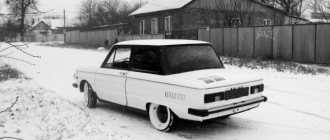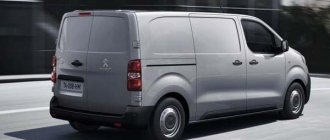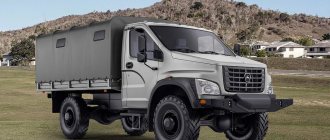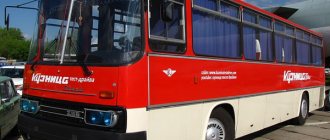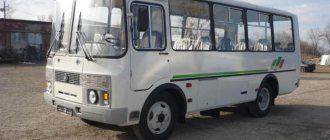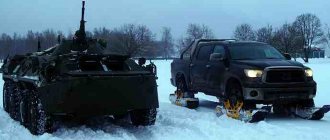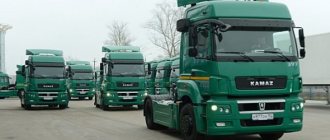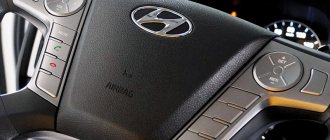Firefighter... Real firefighter
Nikolay Bratashchuk Photo by the author and Adler-m
The abbreviation ATSU stands for tank truck of a simplified design. The experience of using such fire tankers on the chassis of third-generation Gorky trucks has confirmed numerous positive aspects: an affordable, easy-to-use and maintain fire truck with an increased supply of transportable water and the necessary minimum of firefighting equipment.
But there were also design flaws: low performance of the standard mounted pump, increased wear of engine parts due to additional load on the crankshaft, limited functionality (no foam extinguishing function, no ladder of sufficient length).
In the 1980s, OKB-8 began working on the creation of an improved firefighting vehicle, which, while possessing some of the advantages of the ACU, would have higher functional characteristics. Their result was the appearance in 1987 of the ATs-30(53-12)-106G.
From simplified to real
In 1970, at the Arzamas Municipal Engineering Plant, on the basis of documentation developed at the Pozhmashina Design Bureau, a prototype fire tanker of a simplified design ATSU-30/53A/-152 was built, designed to deliver a reduced combat crew of three people to the scene of a fire. -technical weapons (PTV), a supply of fire extinguishing agents (2600 liters of water + 150 liters of foaming agent). With such equipment, the vehicle, of course, had all the capabilities to extinguish a fire. This could be done in three ways: with water from a tank, from a reservoir or from a hydrant, or with air-mechanical foam.
This machine was supposed to replace the ATsU-20(51)-60 in small settlements, which was produced by Vargashinsky from 1962 to 1968. Some design ideas contained in it were later embodied in the ATs-30 (53-12)-106G model .
Taking water from a reservoir using a gas-jet vacuum apparatus
- Attach the discharge and suction hoses, check the tightness of the connections and lower the mesh into the water to a depth of at least 300 mm.
- Close all valves and drain cock.
- Open the vacuum valve (towards you).
- Turn on the gas jet vacuum apparatus.
- Increase engine speed until the vacuum device operates stable.
- When water appears in the sight glass, wait a short time until the air bubbles stop and close the vacuum valve.
- Turn down the gas.
- Smoothly engage the clutch.
- Turn off the vacuum device.
- Increase speed to 2-4 atm. by pressure gauge.
- Smoothly open the valve of the discharge fitting.
- Add gas and bring the pressure to the required value.
- If necessary, open the heat exchanger valve.
The most typical mistakes made by drivers when supplying water from a reservoir:
- Insufficient engine speed when operating the vacuum apparatus.
- Reduce speed until the vacuum valve closes.
- High speed and pressure when opening the discharge fitting.
- Premature closing of the vacuum valve.
- Sudden opening of the discharge fitting.
- Turning the vacuum device on and off at high engine speeds.
- Abrupt engagement of the clutch.
- Engaging and disengaging the clutch at high speeds.
Filling the pump with water
Additional information and explanations
- In winter, in order to prevent the formation of an ice plug in the vacuum system, immediately after water appears in the sight glass, the vacuum valve handle must be moved to its extreme position away from you for a few seconds. Since the vacuum apparatus continues to operate at this time, the remaining water will be forcibly sucked out of the vacuum system. The system will be purged with atmospheric air through the upper vacuum valve and the hole in its body.
- When the pump is filled with water, a small amount of air remains in the lower connection (see Fig. 3).
If, when supplying water to the line, you first open this pipe and release the remaining air, then the likelihood of a break in the water column will decrease. Especially with high suction lift.
- The conical connections of the suction hoses must be kept dry and clean. However, at high suction lifts, two dry cones do not always provide a sufficient seal. Given this, it is advisable to lubricate them before connecting them. The pump suction cone must always be lubricated.
- When working with shut-off fire nozzles, it must be remembered that stopping the flow causes heating of the pump and, as a result, a break in the water column. In winter, during severe frosts, the suction line may freeze. In both cases, it is necessary to provide for additional water discharge into the reservoir.
Realities of today
The start of serial production of AC-30 (53-12) - 106G coincided with the beginning of new economic realities that were difficult for the country, and therefore fire tanks, although they were in demand, with the transition to self-financing and self-sufficiency, many farms were content with what they had and were in no hurry to purchase new technology. This determined, among other things, the selective geography of their distribution. Thus, the RSFSR received the most of them, while other republics, for example, the neighboring Ukrainian SSR and BSSR, received several times less. Therefore, in the former Soviet republics they are very rare, and where they are preserved, they serve, as a rule, in the structure of the local fire department. Unlike other republics of the former USSR, they are still very common in the Russian Federation today. It is enough to type the request in any search engine: ATs-30 (53-12) - 106G to verify the validity of what has been said.
Some cars, after retirement, continue to work as water carriers or utility “emergency trucks”. The cars in the service of the water utility look very interesting. They are often painted blue or blue.
And some “106G” are even used as... vacuum machines - sewer trucks, judging by the ads on car sales websites. Others live quietly... And in order not to end the review of realities on such a sad note, I will say that according to information from colleagues from Siberia, they can see “106G-e” in the colors of the Ministry of Emergency Situations.
A further development of the 106G model was the appearance in the early 1990s of the new AC-30 (3307) - 226 on the GAZ-3307 chassis. The tanker was characterized by a tank enlarged to 3000 liters and the presence of a fire monitor.
Let's sum it up
Despite the already long history of the GAZ-3307 medium-duty truck, it can be found quite often even today on urban and rural roads. It is clear that its appearance is quite far from its European counterparts, but the truck has small dimensions, an average payload and a good power unit, which together allows the vehicle to be used for various purposes, including housing and communal services.
In addition, thanks to good cross-country ability and increased ground clearance, the car can be used even in rural areas for various needs. Inside the cabin, the design staff of the Gorky Automobile Plant tried to make the driver’s working conditions as comfortable as possible, as far as the budget allowed.
If we add a relatively low cost to all these advantages, then the advantage will clearly be on the side of “Lawn”. In addition, the plant provides various modifications that allow the machine to be used in wider areas.
There are several unloading options, which is very important, especially in urban environments. The car can hold the road well, accelerating up to 90 kilometers per hour. In fact, the GAZ-3307 is one of the most acceptable medium-duty trucks in the Russian Federation.
Real fireman to scale
Two years ago, DIP models announced the launch of its “new line”: scale models of fire trucks on the GAZ-52 and GAZ-53 chassis. The first-born in this direction was the ACU-10 (52), and a year later the more advanced ACU-10 (53A) was shown. It is gratifying to note that it was on firefighters that innovations were introduced, which were then fixed on other DiP models. For example, more replica, made by photo-etching, brackets for exterior mirrors and bearings in the hubs of the front wheels became the basis for the “52” chassis, and the three-knee ladder was first shown on the special version of the ATSU-10 (53A), preceding its more widespread use in production of “deep” models.
Filling the tank with water from the pump
Water and foam communications AC-40 (130)
This exercise differs from the usual water supply only in that instead of a discharge fitting, the valve to tank 2 is opened (see Fig. 1).
At the same time, it must be remembered that the internal area of the walls of the ZIL tank is more than 10 m 2 (100,000 cm 2).
With such an area, even a small excess pressure of 0.5 kg/cm creates a breaking force of 50,000 kg.
To avoid tearing the tank, filling should not be carried out under low pressure of 1.5-2 atm. In this case, the control tube has time to pass excess water when the tank overflows.
When water appears from the control tube, the gas is immediately reduced and the clutch is engaged. After this, the valve to the tank is closed.
If it is necessary to speed up the filling of the tank, it is necessary to open the lid of the top hatch of the tank and only then increase the pressure.
Touches to the portrait
Most of the new cars, from the Gorky Automobile Plant, which supplied the chassis, were equipped with K-55A “all-terrain” tires, which significantly improved the cross-country ability of a rear-wheel drive vehicle in conditions of bad roads and seasonal off-road conditions.
The design of the fire truck model 106G on the GAZ-53-12 chassis is based on a welded metal tank of a suitcase-elliptical cross-section, made of St3 sheet steel 3 mm thick and secured to the vehicle frame using stepladders. To ensure a long service life of the tank, its internal surface is coated with coal tar varnish. A distinctive structural feature of the tank filler neck cover from those previously considered is the presence of an adapter connection for fastening a fire hose. The frame of the car in the rear part is extended to accommodate a centrifugal single-stage cantilever pump model PN-40UV, which is driven from the car engine using a separate driveshaft through the power take-off (PTO). Although the value “40” in the pump marking indicates the ability to supply forty liters of extinguishing agent per second, in combination with the “Gazon” carburetor engine with a power of 120 hp, its performance is only 30 l/s.
The pressure pipes are located at the rear of the tanker and are accessible from below the fire superstructure. In the rear part, directly above the pump room, there is a foam concentrate tank. On the sides of the tank there are rectangular compartments with various fire protection equipment. A pair of GPS-600 (medium expansion foam generator) is fixed on top of special brackets.
There are three staircases for different purposes on the roof of the superstructure:
- metal sliding three-legged ladder L-3KM/L-60, providing access to the windows of the third floor or to the roof of a two-story building;
- metal assault ladder LShM with a hook for access to the upper floors of buildings (as well as for working on steep slopes of roofs, for example, when opening the roof);
- folding ladder-stick (LP) - for lifting firefighters to the first floor through the window openings of buildings. In addition to its intended purpose, it can be used as a battering ram when opening doors. But it has one more important property - the ability to be used as a stretcher when carrying out victims.
Paying tribute to the certainly interesting versions that were released, having replenished their collections with ACU variants, collectors were also waiting for more familiar models of fire trucks on familiar chassis.
At the end of June 2022, everyone had the opportunity to purchase a long-awaited new product: a model of a real fire tanker ATs-30 (53-12) - 106G, albeit a single-cabin (according to some colleagues, a real “fire truck” should have a two-cabin). By the way, the start of sales was preceded by an early presentation of working samples, as a result of which some additions and corrections were made, and constructive wishes were taken into account.
The rear part contains such nuances as the features of attaching license plates on different models
Albert Volynsky, DiP models:
“A conventional mold is just a die and a punch that shapes two sides of the part, i.e. the part has flat outer sides. In our case, we also use external and internal wedges that shape the part on four sides, which gives the staircase such realism.”
The model AC-30 (53-12) - 106G, released in four basic versions, which were assigned the corresponding article numbers: 105330, 105331, 105332, 105333, was no exception in terms of new solutions.
Firstly, the body of the fire superstructure is made of ABS using die-cast technology. Secondly, the model received an extended rear overhang of the frame. Thirdly, very realistic foam generators with imitation mesh inside were used for the first time on the roof of the fire superstructure. Fourthly, “all-terrain” tires K-55A appeared on this model for the first time. Fifthly, for the first time in the DiP models production program, the SGU-60 with the FER “Ruhla” flasher is used. Sixthly, a “gas jet” appeared on the exhaust system. Starting with this series of models, license plates of state registration plates have imitation fasteners.
Detailing of fasteners and fire-technical equipment on the superstructure body
At first glance, all versions are very similar, but each of them is individual. And before we consider the features of individual options, let’s get acquainted with the general design solutions.
The position of the rear window has been changed and is now installed more realistically. Through the lowered side windows you can see that inside, like a real fire engine, the open metal parts of the cabin are painted in the base factory color, in our case “Adriatic”, and on the right side of the instrument panel there is a plate with markings. In addition to the searchlight, ladders, and foam generators, each option has additional equipment mounted on the inner walls of the body: a hook, two different crowbars, and a shovel.
All variants of the AC-30(53-12)-106G are presented in transport position and have real prototypes.
Traditionally, each model is accompanied by a corresponding certificate, certifying that a specific model with a certain article number is part of the overall limited edition.
Specifications
Power unit
The Gorky Automobile Plant provided as many as 3 engines. Among them was the presence of an 8-cylinder V-shaped 4-stroke 4.67 liter gasoline engine ZMZ-5231.10.
It had a carburetor power system and liquid cooling and produced 124 horsepower. The compression ratio was 7.6, and it weighed about 275 kilograms. A similar power unit also received an OHV valve mechanism with an exhaust gas recirculation system, along with aluminum blocks.
It can be classified as European standards Euro-3. The engine runs on AI-80 or A-76 gasoline. If you apply additional adjustment, you can use AI-92 gasoline. It was also planned to install a 4-cylinder, four-stroke, 4.75-liter, 125-horsepower diesel engine “MMZ D-245”, which had turbocharging, liquid cooling, direct fuel injection and a charge air cooler.
This engine already complied with the Euro-4 environmental framework. His compression was already equal to 17 units, and he weighed all 430 kilograms. The last representative of this line of engines was YaMZ-5344. It was a four-cylinder, four-stroke diesel power unit with turbocharging, liquid cooling, direct fuel injection and a charge air cooler.
The engine complied with Euro-4 environmental parameters and had a 4.43 liter displacement with a rated power of 134.5 horses. The compression ratio was 17.5. The installation of a pre-heater was provided as a separate option.
Transmission
All diesel powertrains have been synchronized with a 5-speed manual gearbox. The work is carried out using an installed single-plate friction dry clutch, which has a hydraulic control drive.
But for gasoline engines, a 4-speed manual gearbox was provided, which could be easily distinguished by the characteristic howl that it emitted while driving.
Suspension
She is presented here as an addict. At the front there are semi-elliptic springs with shock absorbers. At the rear there are semi-elliptic springs with additional springs. The ends of the main sheets of all springs were installed in the rubber pads of the support brackets.
The drive goes to the rear twin wheels. The suspension was slightly redesigned, after which it was possible to better adapt it for Russian roads.
Steering
It has a worm mechanism, similar to a globoidal worm with a three-ridge roller.
Electrical equipment can support its own operation at 12 volts. The model did not receive a hydraulic power steering wheel.
Brake system
It is considered to be one of the most reliable. It includes brakes and hydraulic drive. In addition, the system has a pair of brake circuits, one of which is responsible for the spare brake. Each circuit has a hydraulic vacuum booster, together with a vacuum cylinder with a shut-off valve.
Thanks to vacuum cylinders, it is possible to achieve independent power supply to the circuits. The vacuum number is monitored using special vacuum measuring instruments, which are equipped with red indicators.
If the vacuum volume reaches the minimum reading, the lamp will begin to glow. There is also a parking brake, and it is represented by a mechanical method of action, and it is installed on the transmission. Drum mechanisms are used to perform braking.
Specifications
| engine's type | ZMZ-511.10 |
| Travel speed (maximum) | 90 km/h |
| Load capacity | 4.5 t |
| Engine power (nominal) | 92 kW |
| Rotation frequency | 3200 rpm |
| Number of engine cylinders | 8 pcs |
| Cylinder diameter | 9.2 cm |
| Piston stroke | 8 cm |
| Working volume | 4.25 l |
| Fuel tank volume | 105 l |
| Fuel consumption per 100 km (speed 60 km/h) | 19.6 l |
| Fuel consumption per 100 km (speed 80 km/h) | 26.4 l |
| Front track size | 1.7 m |
| Rear track size | 1.56 m |
| Wheelbase | 3.77 m |
| Clearance under the rear axle | 0.265 m |
| Clearance under the front beam | 0.347 m |
| Braking distance (speed 60 km/h) | 36.7 m |
| Weight (total) | 7.85 t |
| Weight (curb) | 3.2 t |
| Width | 2.33 m |
| Cabin height | 2.35 m |
| Length | 6.33 m |
| Body type | unloadable on 3 sides |
| Body dimensions inside (length, height, width) | 3.52x0.52x2.28 m |
| Body volume (standard sides) | 5 m³ |
| Body volume (extension sides) | 10 m³ |
| Underbody area | 8 m² |
ATs-30 (53-12) – 106G, article 105334
An early version of the fire truck produced in 1987 on the GAZ-53-12 chassis is a variant with one LBS-5 Elektra flashing light located in the center, equipped with black rims with K-55A all-terrain tires. On the cab and on the back there is the inscription “101 Volodarsk”. The double white stripe on the front is only on the hood, unlike the other options being considered. State registration number – 6229 GOC (Gorky region, RSFSR).
Cabin interior
There is more free space inside. The dashboard received an abundance of all kinds of sensors. A two-spoke steering wheel with a thin rim was installed in front of them. Among the largest sensors on the dashboard are the round powertrain speed sensor on the left and the speedometer mounted in the center.
In addition to them, there are sensors for oil, engine temperature, fuel level, battery charge and pneumatic system. More modern vehicles have fairly good seats with moderate lateral support.
ATs-30 (53-12) – 106G, article 105335
The 1987 version of the fire truck on the GAZ-53-12 chassis is a variant with two LBS-5 Elektra beacons located in front of the cab roof, closer to its corners. It has yellow FG-16PP fog lights on the front bumper and red rims in combination with KI-63 universal tires. On the cabin doors and on the rear wall there is a note “47 Shukhobod”. In addition, above the front wheels there is an indication of the required tire pressure. State registration number – 1009 VOS (Vologda region, RSFSR).
GAZ-3307 photo
New pickup truck - its performance at the auto show
"Ural" - the history of the automobile plant
History of the Lutsk Automobile Plant
Two new GAZ City products for city roads
UAZ - unique SUVs with a legendary history
AC-30 (53-12) – 106G, article 105336
The version of the fire truck, produced in 1991, on the GAZ-53-12 chassis has an SGU-60 on the roof with a beacon of the FER DDR Ruhla type, and a walkie-talkie is attached to the instrument panel. A pair of FG-16PP fog lights with yellow glass are installed above the front bumper. The radiator is covered with a protective apron, which displays a non-standard solution: a white double stripe as a continuation of the color scheme of the fire truck. The car is equipped with KI-63 tires on black wheels, and the rims are painted with white enamel. On the cabin doors the word is SPAS. But this is not an abbreviation like “Tsentrospas”, as you might think, but the name of a settlement in the Kolomyya region. State registration number – 6504 IFN (Ivano-Frankivsk region, Ukrainian SSR).
Advantages and disadvantages
- Good maneuverability;
- Good ground clearance;
- No problems with purchasing spare parts and machine elements;
- Good maintainability;
- Reliable braking system;
- Reasonable cost for both new and used trucks;
- Small dimensions;
- Not afraid of the countryside;
- Various modifications;
- Various possibilities for unloading cargo;
- Unpretentious car;
- Clear and convenient controls;
- There is a seat belt;
- Decent power units;
- Good visibility;
- More free space in the cab.
- Low load capacity;
- Fuel consumption;
- There is no hydraulic power steering;
- The gearbox, which is synchronized with the gasoline power unit, “howls” while driving;
- The simple appearance of the truck;
- Sometimes the engine power is not enough.
ATs-30 (53-12) – 106G, article 105337
Version made in 1987 on the GAZ-53-12 chassis: “only from the factory”, without any designations or license plates. Equipped with two LBS-5 Elektra beacons located in the front of the cabin roof, closer to its corners. K-55A tires are mounted on black rims. But this particular option may bring a pleasant surprise to collectors. She represents a kind of transformer. That is, it can remain in the collection as a model of a new car “from the factory,” or it can become one of the options, as they say, “with a flick of the wrist.” The fact is that the kit includes decals for self-installation, allowing you to make the basic version one of two proposed ones: “36 Urschel” or “18 Vyazniki”.
The official distributor of DiP models products, the Adler-M company, as part of the general circulation of the specified article, offered an exclusive for those who prefer ready-made models: AC-30 (53-12) - 106G with state registration plates of the Russian Federation and symbols of the Ministry of Emergency Situations.
Cost and options
Trucks of this type are used even today. (Brand new) cars are released from the assembly line only to order and in single batches. The price of this truck will vary depending on which superstructure is chosen.
The most popular models are van and board. The cost of such cars (with side) starts at 700,000 rubles. The van will already start from 850,000 rubles. If a lift on a similar platform is needed, then you will have to pay from 1,100,000 rubles for it. If there is a desire to install some auxiliary functions, it is logical to conclude that the cost will rise equally.
You can also purchase a truck on the used market, which will allow you to save a lot on your purchase. But here there is a chance to purchase a problematic vehicle, of which we have plenty in our country.
Depending on what modification will be used, what the condition and year of manufacture will be, the cost of the model will vary from 100,000 to 300,000 rubles. Versions 2014-2016 can rise to 1,000,000 rubles.
The GAZ 3307 truck has a convenient unloading design, which makes it mobile even in urban conditions, providing for unloading on three sides.
The list of basic equipment includes 20-inch steel wheels, standard halogen optics, a rear fog lamp, one battery (6ST-75) or a pair (6ST-55A3) and an interior heater.
It is worth adding that the limited batches produced by the plant received the GAZ-330701 model adapted to cool climatic conditions, which had increased thermal insulation of the cabin, a pre-heater and an optional auxiliary heater.
